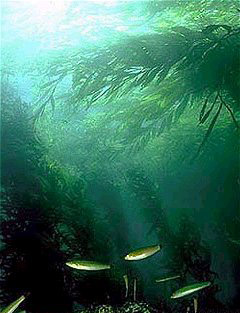Pneumatocyst
A detailed overview of pneumatocysts in various organisms
Pneumatocyst[edit | edit source]
A pneumatocyst is a specialized structure found in certain organisms, primarily in algae and some marine animals. These structures are typically gas-filled bladders that serve various functions, including buoyancy control and storage of gases.
In Algae[edit | edit source]
In large brown algae, such as kelp, pneumatocysts are crucial for maintaining buoyancy. These gas-filled bladders allow the algae to float towards the surface of the water, maximizing their exposure to sunlight for photosynthesis. The gases contained within these bladders are primarily oxygen, nitrogen, and carbon dioxide, which are byproducts of photosynthesis and respiration.
The presence of pneumatocysts in kelp forests is essential for the formation of these underwater ecosystems. By keeping the fronds of the algae afloat, they create a canopy that provides habitat and protection for a variety of marine life, including fish, invertebrates, and marine mammals.
In Marine Animals[edit | edit source]
Some marine animals, such as certain species of jellyfish, also possess structures similar to pneumatocysts. These structures help the animals maintain their position in the water column and can aid in locomotion. However, in jellyfish, these structures are often referred to as "gas bladders" or "floatation sacs" rather than pneumatocysts.
Function and Adaptation[edit | edit source]
The primary function of pneumatocysts is to provide buoyancy, allowing organisms to maintain an optimal position in the water column. This adaptation is particularly important in environments where light availability is a limiting factor for photosynthesis. By floating closer to the surface, algae can access more sunlight, which is crucial for their growth and survival.
Additionally, pneumatocysts can serve as a storage site for gases that are involved in metabolic processes. This can be advantageous in fluctuating environmental conditions, where the availability of gases might vary.
Related pages[edit | edit source]
Search WikiMD
Ad.Tired of being Overweight? Try W8MD's physician weight loss program.
Semaglutide (Ozempic / Wegovy and Tirzepatide (Mounjaro / Zepbound) available.
Advertise on WikiMD
|
WikiMD's Wellness Encyclopedia |
| Let Food Be Thy Medicine Medicine Thy Food - Hippocrates |
Translate this page: - East Asian
中文,
日本,
한국어,
South Asian
हिन्दी,
தமிழ்,
తెలుగు,
Urdu,
ಕನ್ನಡ,
Southeast Asian
Indonesian,
Vietnamese,
Thai,
မြန်မာဘာသာ,
বাংলা
European
español,
Deutsch,
français,
Greek,
português do Brasil,
polski,
română,
русский,
Nederlands,
norsk,
svenska,
suomi,
Italian
Middle Eastern & African
عربى,
Turkish,
Persian,
Hebrew,
Afrikaans,
isiZulu,
Kiswahili,
Other
Bulgarian,
Hungarian,
Czech,
Swedish,
മലയാളം,
मराठी,
ਪੰਜਾਬੀ,
ગુજરાતી,
Portuguese,
Ukrainian
Medical Disclaimer: WikiMD is not a substitute for professional medical advice. The information on WikiMD is provided as an information resource only, may be incorrect, outdated or misleading, and is not to be used or relied on for any diagnostic or treatment purposes. Please consult your health care provider before making any healthcare decisions or for guidance about a specific medical condition. WikiMD expressly disclaims responsibility, and shall have no liability, for any damages, loss, injury, or liability whatsoever suffered as a result of your reliance on the information contained in this site. By visiting this site you agree to the foregoing terms and conditions, which may from time to time be changed or supplemented by WikiMD. If you do not agree to the foregoing terms and conditions, you should not enter or use this site. See full disclaimer.
Credits:Most images are courtesy of Wikimedia commons, and templates, categories Wikipedia, licensed under CC BY SA or similar.
Contributors: Prab R. Tumpati, MD

